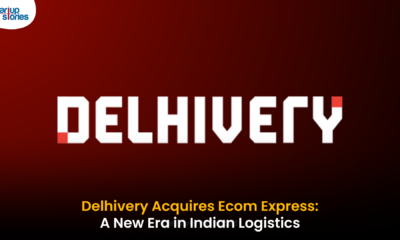News
Navi Surpasses Cred to Become Fourth Largest UPI App in India!

Sachin Bansal’s fintech platform Navi has emerged as the fourth largest UPI app in India, overtaking Kunal Shah-led Cred. According to data from the National Payments Corporation of India (NPCI), Navi witnessed a significant 31% month-on-month growth in October, registering 158 million transactions compared to 120 million in September.
Market Dynamics
Despite Navi’s impressive growth, Cred also saw an increase in transactions, growing from 140 million in September to 152 million in October. However, Navi’s expansion came even as it scaled back its cashback and incentive programs, demonstrating its ability to attract users through its core offerings.
UPI Market Leaders
The UPI market continues to be dominated by:
- PhonePe: 48% market share
- Google Pay: 37% market share
- Paytm: 7% market share
Both Navi and Cred now account for approximately 1% of the UPI market each. Additionally, Flipkart Group’s super.money app has shown rapid growth, doubling its transaction count to 50 million in October and achieving a 0.3% market share.
Impact of Festive Sales
The festive season contributed to an overall 11% increase in UPI transaction volumes and a 14% rise in transaction value during October. This surge highlights the seasonal boost that often accompanies major shopping events in India.
Navi’s Unique Offerings
Unlike many UPI and fintech apps, Navi operates as a manufacturer of financial products. It offers a range of services including:
- Personal loans
- Home loans
- Mutual funds
- Insurance
- Digital gold
This approach distinguishes Navi from competitors who typically act as third-party distributors of financial products.
Resilience Amid Regulatory Challenges
In October, the Reserve Bank of India (RBI) directed Navi Finserv and three other non-banking financial companies (NBFCs) to halt lending practices due to concerns over high interest rates and hidden charges. Notably, this directive did not impact Navi’s UPI operations, allowing it to continue expanding its user base.
Challenges in Market Regulation
The NPCI has faced challenges in implementing a proposed 30% market share cap for UPI apps, aimed at preventing concentration risk within the ecosystem. Currently, PhonePe and Google Pay collectively account for about 85% of UPI transactions, highlighting the dominance of these two players.
NPCI’s Strategic Moves
To foster competition, NPCI has spun off its BHIM app into a separate entity and appointed veteran banker Lalitha Nataraj as its CEO. However, despite these efforts, BHIM has not seen significant growth in transaction volumes this financial year.
Future Prospects
As tier-two UPI apps like Navi and super.money gain traction, competition in India’s UPI ecosystem is intensifying. With plans to introduce innovative credit products—such as RuPay credit cards on UPI—emerging players are poised to disrupt the market further. Meanwhile, the dominance of leading apps remains a challenge for regulators aiming to promote a more balanced ecosystem.
Conclusion
Navi’s rise to become the fourth-largest UPI app marks a significant milestone in India’s digital payment landscape. By leveraging its unique business model and navigating regulatory challenges effectively, Navi is positioned for continued growth. As competition heats up among fintech players, the evolution of the UPI ecosystem will be crucial for enhancing financial inclusion across India.
News
BMW’s New Logo Debuts Subtly on the All-Electric iX3: A Modern Evolution

BMW quietly debuted its new logo on the all-electric iX3, marking a significant yet understated shift in the brand’s design direction for 2025. The updated emblem retains the classic roundel and Bavarian blue-and-white colors, but sharp-eyed enthusiasts noticed subtle refinements: the inner chrome ring has been removed, dividing lines between blue and white are gone, and the logo now features a contemporary satin matte black background with slimmer “BMW” lettering. These enhancements showcase BMW’s embrace of modern minimalism while reinforcing their commitment to premium aesthetics and the innovative Neue Klasse philosophy for future electric vehicles.
Unlike rival automakers that reveal dramatic logo changes, BMW’s refresh is evolutionary and respectful of tradition. The new badge ditches decorative chrome and blue borders associated with earlier electric models, resulting in a flatter, more digital-friendly design that mirrors recent branding seen in BMW’s digital communications. Appearing first on the iX3’s nose, steering wheel, and hub caps, this updated identity will gradually be adopted across all BMW models—both electric and combustion—signaling a unified brand language for years to come.
BMW’s strategic logo update represents more than just aesthetic reinvention—it underscores the brand’s dedication to future-ready mobility, design continuity, and a premium EV experience. As the new roundel begins rolling out on upcoming BMW vehicles, it stands as a testament to the automaker’s depth of detail and thoughtful evolution, offering subtle distinction for keen observers and affirming BMW’s iconic status in the ever-changing automotive landscape.
News
iPhone 17 India Price, Features & Availability: All You Need to Know

Apple has officially launched the highly anticipated iPhone 17 series in India, with prices starting at INR 82,900 for the base 256GB model. The new lineup includes the iPhone 17, iPhone 17 Pro, iPhone 17 Pro Max, and the newly introduced ultra-slim iPhone Air. Apple has removed the 128GB storage variant, making 256GB the minimum for all models. The standard iPhone 17 features a vibrant 6.3-inch ProMotion OLED display with a 120Hz refresh rate and an upgraded Ceramic Shield 2 for improved durability. It comes in fresh color options like lavender, mist blue, sage, white, and black.
The iPhone 17 Pro and Pro Max models are powered by Apple’s latest A19 Pro chip and start at INR 1,34,900 and INR 1,49,900, respectively. These Pro models feature sleek titanium frames, significant camera upgrades including 8K video recording, and up to 6x optical zoom in the Pro Max. Meanwhile, the iPhone Air, priced from INR 1,19,900, is the slimmest and lightest iPhone ever, boasting a 6.7-inch Super Retina XDR display with ProMotion technology and a triple-camera setup, positioning itself between the standard and Pro models.
Pre-orders for the iPhone 17 series commence on September 12, with sales beginning on September 19, 2025. Alongside the launch, Apple has reduced prices for the previous iPhone 16 models while discontinuing the iPhone 16 Pro and Pro Max variants. The iPhone 17 series exemplifies Apple’s ongoing commitment to enhancing display technology, camera capabilities, and overall performance, setting a new benchmark for premium smartphones in the Indian market.
Startup News
Meet the 13 Deeptech Startups Empowered by BIGShift Accelerator in India

India’s deeptech ecosystem has reached a significant milestone with the launch of BIGShift, a premier accelerator programme by Inc42 and India Accelerator designed to empower early-stage startups developing breakthrough technologies. The first cohort comprises 13 innovative startups addressing complex challenges in fields such as artificial intelligence, aerospace, robotics, healthcare, and geospatial analytics. These startups benefitted from specialized capital-readiness training, strategic mentorship, and direct access to investors interested in supporting high-risk, high-reward deeptech ventures, making BIGShift a crucial platform for nurturing India’s next-generation technology leaders.
The accelerator programme uniquely combines virtual bootcamp sessions with a comprehensive two-day in-person masterclass, equipping startups with advanced go-to-market strategies, funding expertise, and a valuable network of experienced operator-mentors. Noteworthy startups from the cohort include ActionSync, focused on enterprise data unification; Polygon Geospatial, delivering AI-powered real-time spatial analytics; Purna AI, which innovates in preventive health through genetic biomarkers; Spacetaxi, pursuing reusable commercial rockets; and VertiFly, specializing in hybrid eVTOL aerial mobility solutions. This diverse group exemplifies the ingenuity and pioneering spirit of Indian deeptech entrepreneurship across multiple high-impact sectors.
BIGShift’s inaugural cohort not only accelerates technological development but also provides critical support mechanisms like pilot project matchmaking, regulatory guidance, and facilitating enterprise collaborations. As these 13 startups transition their groundbreaking solutions from the lab to the marketplace, BIGShift is poised to be a catalyst for deeptech innovation in India, helping transform scientific research into scalable, impactful businesses that will shape the country’s technological future.














Δημιουργα δωρεν λογαριασμο
June 29, 2025 at 2:51 am
I don’t think the title of your article matches the content lol. Just kidding, mainly because I had some doubts after reading the article.
binance open account
September 27, 2025 at 8:25 pm
Thanks for sharing. I read many of your blog posts, cool, your blog is very good.
binance
October 4, 2025 at 11:10 pm
Can you be more specific about the content of your article? After reading it, I still have some doubts. Hope you can help me.
J88
November 6, 2025 at 6:23 am
Đến với J88, bạn sẽ được trải nghiệm dịch vụ cá cược chuyên nghiệp cùng hàng ngàn sự kiện khuyến mãi độc quyền.
Kuwin
November 10, 2025 at 11:33 pm
kuwin sở hữu kho game đa dạng từ slot đến trò chơi bài đổi thưởng, mang đến cho bạn những giây phút giải trí tuyệt vời.
谷歌站群
November 11, 2025 at 12:36 am
专业构建与管理谷歌站群网络,助力品牌实现全域流量的强势增长。谷歌站群
GO88
November 19, 2025 at 1:58 am
Tham gia cộng đồng game thủ tại Go88 để trải nghiệm các trò chơi bài, poker phổ biến nhất hiện nay.
iwin
November 22, 2025 at 3:08 am
iwin – nền tảng game bài đổi thưởng uy tín, nơi bạn có thể thử vận may và tận hưởng nhiều tựa game hấp
MM88
December 3, 2025 at 3:55 am
Với giao diện mượt mà và ưu đãi hấp dẫn, MM88 là lựa chọn lý tưởng cho các tín đồ giải trí trực tuyến.